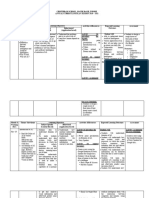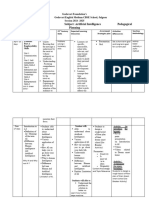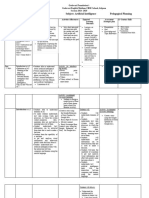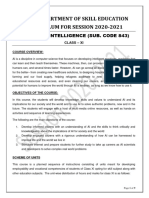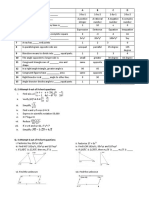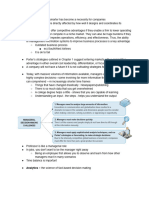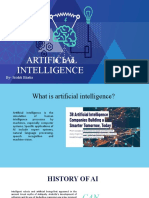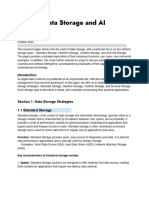Lahore Grammar School
Landmark, Izmir Town, Lahore
Artificial Intelligence
2024
Lecture 1: Introduction to Artificial Intelligence
Objective: Understand the definition of AI, its history, and real-world applications.
Key Concepts:
o Definition of AI (What is AI?)
o Difference between AI, machine learning, and robotics.
o A brief history of AI development.
o Examples of AI in everyday life (Siri, Google Search, Netflix recommendations).
Activities:
o Class discussion: Identify where students have encountered AI.
Assignment:
o Research and find 3 everyday examples of AI to share in the next class.
Lecture 2: Types of AI
Objective: Differentiate between types of AI (Narrow AI, General AI, and Super AI).
Key Concepts:
o Narrow AI (specialized tasks like facial recognition, chess playing).
o General AI (human-level intelligence, not yet developed).
o Super AI (beyond human intelligence, theoretical).
Activities:
o Group work: Students work in pairs to list different types of AI they’ve seen or
read about.
Assignment:
o Find 3 everyday examples of different types of AI to share in the next class.
Lecture 3: Machine Learning Basics
Objective: Introduction to the concept of machine learning and how machines learn from data.
Key Concepts:
o What is machine learning?
o Supervised vs unsupervised learning.
o Real-world applications of machine learning.
Activities:
� o Show examples of machine learning in applications like spam filtering or product
recommendations.
Assignment:
o Find examples of supervised and unsupervised learning.
Lecture 4: Neural Networks
Objective: Introduction to the basic idea behind neural networks and how they mimic the human
brain.
Key Concepts:
o What are neural networks?
o How neural networks are inspired by the human brain.
o Applications of neural networks (e.g., handwriting recognition, image
processing).
Activities:
o Visual demonstration: Explain neural networks with a simple diagram.
Assignment:
o Write a paragraph on how neural networks are similar to and different from the
human brain.
Lecture 5: AI in Games
Objective: Explore how AI is used in video games and simulations.
Key Concepts:
o AI in gaming: Pathfinding, decision-making, non-player characters (NPCs).
o Basic algorithms in games (e.g., A* pathfinding).
Activities:
o Class discussion: How does the AI decide what to do next in a game?
Assignment:
o Choose your favorite game and explain how you think AI is used in it.
Lecture 6: Chatbots and Natural Language Processing (NLP)
Objective: Learn how chatbots and AI-powered assistants work using NLP.
Key Concepts:
o What is NLP? (Understanding and generating human language).
o How chatbots are trained (e.g., customer service bots).
o Limitations of current chatbots.
Activities:
o Create a basic chatbot script with preset questions and answers.
Assignment:
� o Write down five questions you would like to ask a chatbot and the answers it
should provide.
Lecture 7: AI, Ethics and Business Strategies
Objective: Discuss the ethical considerations surrounding AI.
Key Concepts:
o Ethical issues: Privacy, bias, and job displacement.
o The importance of responsible AI development.
Activities:
o Class debate: Is AI helpful or harmful? Split the class into two groups.
o Discuss real-world AI ethics examples (e.g., AI in hiring decisions, facial
recognition controversies).
Assignment:
o Write a paragraph on one ethical concern related to AI and how you would solve
it.
Lecture 8: The Future of AI and Careers in AI
Objective: Discuss the future possibilities of AI and careers in the AI field.
Key Concepts:
o Emerging trends in AI (e.g., autonomous vehicles, smart cities).
o AI in various industries (healthcare, education, entertainment).
o Careers related to AI: Data scientist, AI researcher, machine learning engineer.
Activities:
o Group discussion: What future AI inventions do you think will exist in 10 years?
Assignment:
o Research and present a career in AI that interests you.

